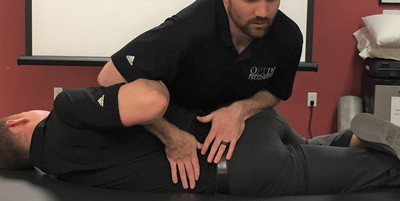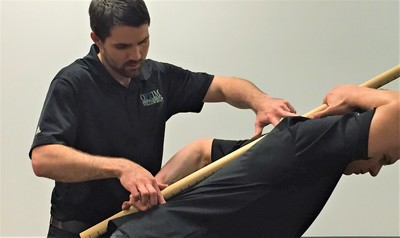- Home
- About Us
- TSPT Academy
- Online Courses
-
Resources
- Newsletter
- Business Minded Sports Physio Podcast
- Day in the Life of a Sports PT
- Residency Corner
-
Special Tests
>
-
Cervical Spine
>
- Alar Ligament Test
- Bakody's Sign
- Cervical Distraction Test
- Cervical Rotation Lateral Flexion Test
- Craniocervical Flexion Test (CCFT)
- Deep Neck Flexor Endurance Test
- Posterior-Anterior Segmental Mobility
- Segmental Mobility
- Sharp-Purser Test
- Spurling's Maneuver
- Transverse Ligament Test
- ULNT - Median
- ULNT - Radial
- ULNT - Ulnar
- Vertebral Artery Test
- Thoracic Spine >
-
Lumbar Spine/Sacroiliac Joint
>
- Active Sit-Up Test
- Alternate Gillet Test
- Crossed Straight Leg Raise Test
- Extensor Endurance Test
- FABER Test
- Fortin's Sign
- Gaenslen Test
- Gillet Test
- Gower's Sign
- Lumbar Quadrant Test
- POSH Test
- Posteroanterior Mobility
- Prone Knee Bend Test
- Prone Instability Test
- Resisted Abduction Test
- Sacral Clearing Test
- Seated Forward Flexion Test
- SIJ Compression/Distraction Test
- Slump Test
- Sphinx Test
- Spine Rotators & Multifidus Test
- Squish Test
- Standing Forward Flexion Test
- Straight Leg Raise Test
- Supine to Long Sit Test
-
Shoulder
>
- Active Compression Test
- Anterior Apprehension
- Biceps Load Test II
- Drop Arm Sign
- External Rotation Lag Sign
- Hawkins-Kennedy Impingement Sign
- Horizontal Adduction Test
- Internal Rotation Lag Sign
- Jobe Test
- Ludington's Test
- Neer Test
- Painful Arc Sign
- Pronated Load Test
- Resisted Supination External Rotation Test
- Speed's Test
- Posterior Apprehension
- Sulcus Sign
- Thoracic Outlet Tests >
- Yergason's Test
- Elbow >
- Wrist/Hand >
- Hip >
- Knee >
- Foot/Ankle >
-
Cervical Spine
>
- I want Financial Freedom
- I want Professional Growth
- I want Clinical Mastery
Sphinx Test
Purpose of Test: To assess for sacral torsion.
Test Position: Prone.
Performing the Test: The examiner palpates the sacral sulcus and inferior angle of the sacrum on each side, while the patient is in the prone position. Assess sacral sulci and inferior angles to see if they are symmetrical or asymmetrical. Have the patient move up onto his/her elbows, so he/she is prone on elbows. If the landmarks become more symmetrical, it is a forward torsion. If the landmarks become more asymmetrical, it is a backward torsion.
Diagnostic Accuracy: Unknown.
Importance of Test: The sacrum has two commonly known positions: flexion (nutation) and extension (counternutation). As with any joint, one bone can move relative to another, and as a result, there may be different axes of rotation based on which bone is moving on the other. If the sacrum is rotating on the ilium, an oblique axis is used, which runs from one sacral sulcus through the opposite inferior angle of the sacrum. Sometimes, as with any other joint, structures can block or limit the normal motion of the sacroiliac joint. This may present as an asymmetrical sacrum, which could signify forward torsion or backward torsion. With forward torsion, the sacrum can be rotated left on left or right on right. The second direction in each phrase signifies the axis by naming the side of the sacral sulcus axis, and the first direction signifies the direction the sacrum is rotated. For example, right on right means that the axis is running through the left inferior angle and right sacral sulcus, so the sacrum is facing to the right. In this condition, you will feel the sacral sulcus deeper on the left than the right, and the inferior angle more superficial on the right than the left. In a backward torsion, the axis is again identified by the second direction: left on right and right on left. For example, with a left on right, the sacral sulcus will feel deeper on the right than the left, and the inferior angle will feel more superficial on the left than the right. Without the sphinx test it would be difficult to distinguish between a left on right and left on left or between a right on right and a right on left. You then utilize the sphinx test to see if the landmarks become more symmetrical or more asymmetrical to differentiate between the two, and thus backward torsions and forward torsions.
Note: tests should only be performed by a properly trained health care practitioner.
Test Position: Prone.
Performing the Test: The examiner palpates the sacral sulcus and inferior angle of the sacrum on each side, while the patient is in the prone position. Assess sacral sulci and inferior angles to see if they are symmetrical or asymmetrical. Have the patient move up onto his/her elbows, so he/she is prone on elbows. If the landmarks become more symmetrical, it is a forward torsion. If the landmarks become more asymmetrical, it is a backward torsion.
Diagnostic Accuracy: Unknown.
Importance of Test: The sacrum has two commonly known positions: flexion (nutation) and extension (counternutation). As with any joint, one bone can move relative to another, and as a result, there may be different axes of rotation based on which bone is moving on the other. If the sacrum is rotating on the ilium, an oblique axis is used, which runs from one sacral sulcus through the opposite inferior angle of the sacrum. Sometimes, as with any other joint, structures can block or limit the normal motion of the sacroiliac joint. This may present as an asymmetrical sacrum, which could signify forward torsion or backward torsion. With forward torsion, the sacrum can be rotated left on left or right on right. The second direction in each phrase signifies the axis by naming the side of the sacral sulcus axis, and the first direction signifies the direction the sacrum is rotated. For example, right on right means that the axis is running through the left inferior angle and right sacral sulcus, so the sacrum is facing to the right. In this condition, you will feel the sacral sulcus deeper on the left than the right, and the inferior angle more superficial on the right than the left. In a backward torsion, the axis is again identified by the second direction: left on right and right on left. For example, with a left on right, the sacral sulcus will feel deeper on the right than the left, and the inferior angle will feel more superficial on the left than the right. Without the sphinx test it would be difficult to distinguish between a left on right and left on left or between a right on right and a right on left. You then utilize the sphinx test to see if the landmarks become more symmetrical or more asymmetrical to differentiate between the two, and thus backward torsions and forward torsions.
Note: tests should only be performed by a properly trained health care practitioner.
Copyright © The Student Physical Therapist LLC 2023




